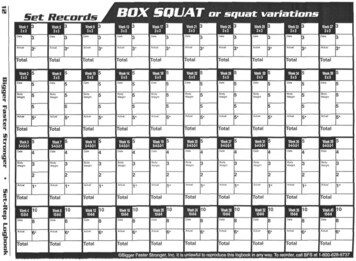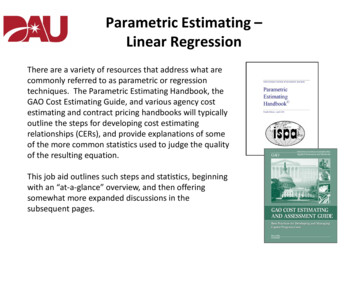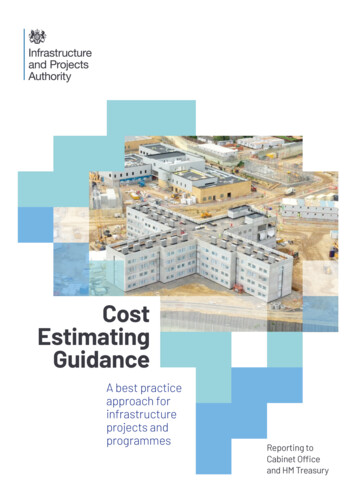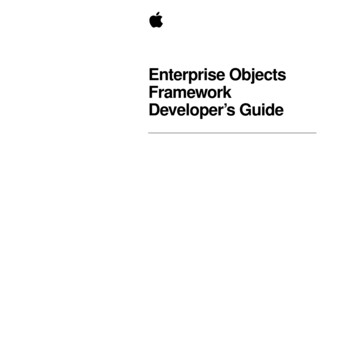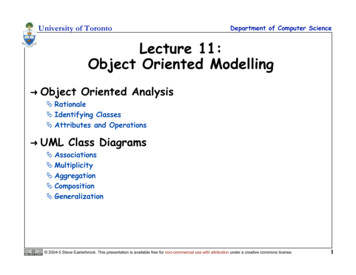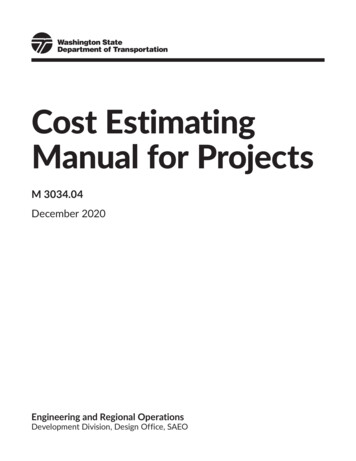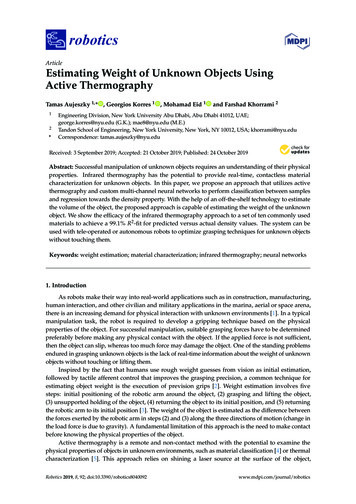
Transcription
roboticsArticleEstimating Weight of Unknown Objects UsingActive ThermographyTamas Aujeszky 1, * , Georgios Korres 1 , Mohamad Eid 112*and Farshad Khorrami 2Engineering Division, New York University Abu Dhabi, Abu Dhabi 41012, UAE;george.korres@nyu.edu (G.K.); mae8@nyu.edu (M.E.)Tandon School of Engineering, New York University, New York, NY 10012, USA; khorrami@nyu.eduCorrespondence: tamas.aujeszky@nyu.eduReceived: 3 September 2019; Accepted: 21 October 2019; Published: 24 October 2019 Abstract: Successful manipulation of unknown objects requires an understanding of their physicalproperties. Infrared thermography has the potential to provide real-time, contactless materialcharacterization for unknown objects. In this paper, we propose an approach that utilizes activethermography and custom multi-channel neural networks to perform classification between samplesand regression towards the density property. With the help of an off-the-shelf technology to estimatethe volume of the object, the proposed approach is capable of estimating the weight of the unknownobject. We show the efficacy of the infrared thermography approach to a set of ten commonly usedmaterials to achieve a 99.1% R2 -fit for predicted versus actual density values. The system can beused with tele-operated or autonomous robots to optimize grasping techniques for unknown objectswithout touching them.Keywords: weight estimation; material characterization; infrared thermography; neural networks1. IntroductionAs robots make their way into real-world applications such as in construction, manufacturing,human interaction, and other civilian and military applications in the marina, aerial or space arena,there is an increasing demand for physical interaction with unknown environments [1]. In a typicalmanipulation task, the robot is required to develop a gripping technique based on the physicalproperties of the object. For successful manipulation, suitable grasping forces have to be determinedpreferably before making any physical contact with the object. If the applied force is not sufficient,then the object can slip, whereas too much force may damage the object. One of the standing problemsendured in grasping unknown objects is the lack of real-time information about the weight of unknownobjects without touching or lifting them.Inspired by the fact that humans use rough weight guesses from vision as initial estimation,followed by tactile afferent control that improves the grasping precision, a common technique forestimating object weight is the execution of prevision grips [2]. Weight estimation involves fivesteps: initial positioning of the robotic arm around the object, (2) grasping and lifting the object,(3) unsupported holding of the object, (4) returning the object to its initial position, and (5) returningthe robotic arm to its initial position [3]. The weight of the object is estimated as the difference betweenthe forces exerted by the robotic arm in steps (2) and (3) along the three directions of motion (change inthe load force is due to gravity). A fundamental limitation of this approach is the need to make contactbefore knowing the physical properties of the object.Active thermography is a remote and non-contact method with the potential to examine thephysical properties of objects in unknown environments, such as material classification [4] or thermalcharacterization [5]. This approach relies on shining a laser source at the surface of the object,Robotics 2019, 8, 92; botics
Robotics 2019, 8, 922 of 13uses a thermal camera to examine the dissipation of thermal heat at the surface of the object, and feedsthe thermal stream into a machine learning classifier or regressor to identify the material class of theobject or to estimate its corresponding physical properties. In this paper, we present an approachto estimate the weight of an unknown object by estimating the density of the object using activethermography and estimating its the volume. The approach feeds the thermal signatures into a custommulti-channel neural network to estimate the density of the object and combines it with the volumemeasurement to estimate the weight of the object.In a real-world application, the Haptic Eye system would be mounted on a robotic system.Whenever the robot intends to physically manipulate with an unknown object, it activates the HapticEye system to estimate the physical properties of the object before touching it. The robot may tailor itsapproach for physical interaction with the unknown object accordingly. An interesting scenario is that,when the robot intends to lift the unknown object, it needs to know about its weight to optimize thegrasping task.Heat transfer principles, described using the heat equation, suggest that the rate at whichthe material at a point will heat up (or cool down) is proportional to how much hotter (or cooler)the surrounding material is [6]. The thermal diffusivity is dependent on the thermal conductivity,the specific heat, and the density of the material. Therefore, the proposed approach capitalizes onsuch a relationship to estimate density of material by observing the corresponding thermal properties.The contributions of this paper include the following: A proposal for the weight estimation framework for physical interaction with unknown objects.A realization of the proposed framework using a multi-channel neural network.Experimental validation and testing of its characterization functionality with results that improveon the state of the art.The rest of this paper is organized as follows: Section 2 gives an overview of the existingapproaches for weight estimation. Section 3 contains a conceptual presentation of our approach,including a description of the weight estimation framework. A realization of this framework isdescribed in Section 4, including density estimation, volume estimation, and the results. The findingsas well as the limitations of the proposed approach are discussed in Section 5. Finally, conclusions aredrawn in Section 6, along with stating our future directions for research.2. Related WorkRecent developments in computer vision and machine learning have opened the door to explorethe possibility of estimating the weight of an object using visual information obtained from 2D or 3Dcameras. Weight estimation for specific materials is already explored, such as detecting the weight ofAlaskan salmon [7], beef [8], pigs [9], and human body parts [10]. A broader list of food classes suchas banana or bread are considered for computing the mass in [11]. The system solves a classificationproblem to find out the material type and looks up a pre-measured density for that object materialas an estimate of the object’s density. A similar method used videos of simple platonic solids withan object tracker and a physical simulator to learn parameters of the simulator, including the mass ofthe object [12]. Another interesting work created a large-scale dataset containing both the images ofobjects and their mass information that is easily available [13]. The system used the 2D image of theobject to estimate its weight. Results demonstrated that the proposed model performed significantlybetter than humans (to estimate weight of familiar objects). However, an unresolved challenge is theability to estimate the weight of objects which the system has not been trained for.Inspired by how humans estimate the weight of unknown objects by unsupported holding,a fundamentally different approach involves a robotic arm performing a precision grip of the objectto estimate its weight [14]. The robotic arm is equipped with tactile sensors for slip detection andto measure contact forces during object manipulation (holding). Recent advances in tactile sensingtechnologies such as BioTac [15], OptoForce [16] and the skinline magnetic-based technology [17]
Robotics 2019, 8, 923 of 13boosted this approach. In a recent work [18], a robotic gripper is used to estimate a target object’sgeometric information and center of mass using 3D soft force sensors. Results demonstrated theability of the system to discriminate objects that have identical external properties but different massdistributions. The authors in [3] presented a manipulation action of power grasp with an onlineestimation of object weight within a very short time (0.5–0.7 s), in the absence of friction interactionbetween the object and the grasping arm. In a subsequent work [19], the weight of the object isestimated from currents flowing in motor servos where results showed successful estimation of theweight of the object with a 22% average error. A method is also presented in [14] for estimating the massof an object using a precision grip on a humanoid robot. A recent research work presented a method toestimate the weight of an object during a precision grip made by a humanoid robot where tactile sensorson the fingertips provide 3D force information during a movement of grasping and lifting a cup filledwith different masses, with static and dynamic friction taken into consideration [20]. The system is ableto calculate the object weight for eight different masses, with satisfactory performance. This approachis challenged by several factors. First, of all, weight perception with humans is not always reliable, dueto a phenomenon known as weight illusion [21], caused by the object’s size and material. Furthermore,the approach requires physical contact before learning about the weight of the object, which increasesthe chances of slippage (the state of the art reports an 80% success rate for detecting slip, which is notgood enough for many applications).An emerging, interesting approach is to use active thermography for material characterization [4,5].A model-based approach for characterizing unknown materials using laser thermography is proposedin [4]. Results demonstrated the ability of the approach to classify different materials based on theirthermal properties. In a subsequent work [5], an approach is proposed to combine infrared thermographywith machine learning for a fast, accurate classification of objects with different material composition.Results showed that a classification accuracy of around 97% can be achieved with majority vote decisiontree classification. In this paper, we aim to extend this approach for classification and regression in orderto estimate the density of the material based on thermal signature and an off-the-shelf volume estimationtechnique to estimate the weight of an unknown object using convolutional neural networks.3. Weight Estimation FrameworkThe proposed approach is depicted in Figure 1, and it consists of two processes working in parallel:volume estimation and density estimation. Volume estimation may rely on off-the-shelf techniquesto contactlessly measure the volume of a sample. Existing methods, such as [22], can be applied tomeasure the volume of unknown samples. This is considered beyond the scope of this research andthus the current study focuses on estimating the density of the sampled material.The density estimation is done by using an infrared thermography setup. A Software Controller isresponsible for initiating the procedure and delivering the detailed instructions to the Laser Controller,which in turn supplies control input (excitation timing, duration, shape, waveform, etc.) to the LaserSource and the optional Steering Stage, which can be used if a scanning motion over a multitude ofexcitation locations is carried out. The excitation provided by the Laser Source component hits thesurface of the Sample and results in heating it up by a minuscule amount. This creates a thermalgradient over the surface of the sample around the excitation location, and it evolves over time in a waythat depends on the thermal properties of the material. The Thermal Camera captures this process ina series of radiometric or thermal frames and passes them onto the next stage, where these data areprocessed and fed into a machine learning algorithm. The output of this component is an estimate onthe density of the material. This is then combined with the output of the volume estimation componentto yield a weight estimate.
Robotics 2019, 8, 924 of 13Figure 1. The proposed weight estimation framework.4. Experimental RealizationThis section details how the components of the Weight Estimation Framework can be realized.4.1. Sample Material SetThe literature about material science reports four families of physical material: polymers, ceramics,metals, and composites [23]. A sample set of 10 materials is designed with three selection criteria:(1) samples must represent the four families of material, (2) samples entail a large range of thermalproperties (thermal conductivity, diffusivity, and effusivity ranges), and (3) samples are highlyavailable in every day’s life. Based on these criteria, five polymer samples are selected, namely,silicone, acrylic glass, sorbothane, polyethylene, and coal (as a polymer composite). Similarly,two composite material samples are considered, namely low pressure laminate and high pressurelaminate. Concrete and marble (as ceramic composites) are going to represent the ceramic family.Finally, steel is included as a widely available metal. A snapshot of these samples is shown in Figure 2.Note that these samples are also selected with variations in size, shape, and weight properties in orderto examine the robustness of the proposed approach and thus the suitability for real-world applications.Figure 2. The original samples used for this experiment. Top row, left to right: acrylic glass,machining polyethylene, silicone, sorbothane and concrete. Bottom row, left to right: coal, steel,high-pressure laminate (HPL), low-pressure laminate (LPL), black marble.
Robotics 2019, 8, 925 of 134.2. Density Estimation4.2.1. Experimental SetupThe experimental setup consisted of the following elements: a US-Lasers Inc. D405-120 laserdiode (La Puente, California, USA) with a wavelength of 405 nm and an operating power of 120 mWperformed the excitation on the sample object, and a Xenics Gobi-640-GigE thermal camera (Leuven,Belgium) was responsible for recording the data in radiometric mode. The camera works in thelongwave infrared range (LWIR), which corresponds to the 8–14 µm wavelength range. Its NoiseEquivalent Temperature Difference (NETD) in thermographic mode is rated to be not more than 50 mK.The camera was located 19.5 cm away from the sample, while the laser diode was a further 3 cmbehind it. Figure 3 shows this active thermography setup with the concrete sample in place.Figure 3. The experimental setup.The recorded footage had a resolution of 640 pixels across the width and 480 pixels high witha frame rate of 50 Hz, where the individual pixels represent the radiometric measurements on thecorresponding locations of the surface of the object on a 16-bit scale. An Arduino board was responsiblefor controlling a relay that turns the laser on and off. This board was connected to a desktop PC andwas controlled through a serial connection, while the camera was connected to the PC through GigabitEthernet for control of the recording process and acquiring the recorded data. The PC ran a scriptin MATLAB R2018a that simultaneously controlled the Arduino board and the thermal camera toensure these elements are synchronized throughout the data acquisition process. A total of 10 differentsamples were used for this experiment. These are listed in Table 1 and shown in Figure 2.Table 1. List of samples and their normalized physical properties.SampleWeight (g)Volume (cm3 )Density (g/cm3 )ConcretePolyethylene (PE)AcrylicCoalMarbleSorbothaneLow-Pressure Laminate (LPL)High-Pressure Laminate .681.407.751.40
Robotics 2019, 8, 926 of 134.2.2. Data Acquisition and ProcessingThe data acquisition consisted of two parts: acquiring the predictor data (radiometric frames andtime stamps) and the target data (density values).The predictor data acquisition took place in a set of 10 successive sessions over 10 days.Each session consisted of 10 experimental rounds for a certain sample, then the same 10 roundsfor the next sample, and so on. An experimental round contained the following steps: first, the camerarecords 40 frames without any laser excitation. These frames were used later in the processing phaseto remove the ambient component of the signal. Once these frames are recorded, the laser diodeturns on for 5 s to provide the excitation. As soon as this time is over, the laser diode turns offand simultaneously the camera begins to record a series of 100 frames, which act as the signal part.Given the 50 Hz frame rate of the camera, this process takes less than 8 s, and it is followed bya timeout of 2 min before the next round takes place to avoid any interference between the excitationof subsequent rounds.The target data acquisition involved determining the density values of each of the samples.Measuring the weight of each samples was conducted with scales, while measuring the volumeinvolved measuring the dimensionality of rectangular samples, cutting the non-rectangular samplesinto rectangular shape (normalization) or using measuring tubes to determine their volumes based onthe change in water level in the tube before and after they are fully submerged. The acquired valuesare visible in Table 1. It can be noted that concrete, polyethylene (PE), TRESPA (HPL) and siliconesamples had density values that are very close to each other. On the one hand, this meant to challengethe network to predict a similar value for each of these different materials while others have markedlydifferent values. On the other hand, it also served as an illustration to real world conditions whereseemingly different materials can have similar densities.The radiometric data are processed in several steps being used as the input to the neural network.This includes, for each experimental round, using the average of the 40 pre-excitation frames andsubtracting it from each of the 100 frames recorded after the excitation. This ensures that the systemcan be more robust with respect to changes in the ambient temperature. These frames are also cropped toa resolution of 320 pixels in width and 240 pixels in height containing the excitation region so even if thesample is relatively small, its background will not distort the signal. Finally, the center of the excitation isdetermined based on a smoothed average of the first 10 frames, and the frames are cropped to the 41 pixelsof width and 41 pixels of height region of this point.Figure 4 demonstrates visually, using an example of three frames in the same experimental round,how the thermal dissipation is varying depending on the material properties of the sample. Note thatthe increase in temperature varied between the samples as it is dependent on the material’s thermaleffusivity, but this temperature change never exceeded more than two degrees for any of the samples.
Robotics 2019, 8, 927 of 13Figure 4. Radiometric frames #1, #50 and #100 for Sorbothane and Concrete, in session 3, round 7(enhanced contrast).4.2.3. Neural Network Design and TrainingWhen designing the neural network to perform regression on the radiometric frames to the densityvalues, it was essential to abide by the limitations posed by the size of the data set, yet take advantageof all the information that the system can rely on. Using an entire recording as data for a single densityvalue would have meant that our entire data set has a size of 1000, which is not enough to train a neuralnetwork. Therefore, we have decided to examine if the network is capable of predicting the density froma single thermal frame. This meant our data set size is the total number of frames, which is 100,000.This was enough to train a shallow convolutional neural network. Having tried various designs, wehave arrived at a network that takes the individual frames with 41 pixels width by 41 pixels heightresolution and puts them through two convolutional stages. Both of these convolutional stages consistof a convolutional layer with a 3-by-3 kernel and 3 output channels, a max-pooling layer with 2-by-2size and a stride of 1, and a batch normalization layer. These are followed by a fully connected stageconsisting of a fully connected layer with 16 hidden units, and an output layer with a single unit that issupposed to be the numerical value expressing the density in g/cm3 . All layers before the output layerrely on sigmoid activation.Given that we ended up using the individual frames as separate data points, it can be a challenge forthe network to correctly equate the first and the last image of the same recording and predict identical(or near-identical) values for them, given that they are captured when different amounts of time havepassed since the end of the excitation. In order to overcome this challenge, we added an auxiliary scalarinput to the network, in parallel to the convolutional stages. This input carries the value of the framenumber (1 to 100 according to its location in its recording) and helps the network counteract the possiblediscrepancy between different time delays between the end of excitation and the capturing of the frames.This auxiliary input is concatenated to the flattened output of the second convolutional stage and thesetogether serve as the input for the network. The final multi-channel neural network has 5577 trainableparameters and its structure is visible in Figure 5. In order to evaluate the suitability of this network,we have devised two other regressors for comparison. The ”baseline 1” network lacks the auxiliarytime input but is otherwise identical to the multi-channel neural network. The ”baseline 2” network isan ordinary linear regression model that uses each pixel as separate predictors.
Robotics 2019, 8, 928 of 13Figure 5. Diagram of the multi-channel neural network architecture showing the auxiliary time input.The convolutional stages each consist of a convolutional layer, a max-pooling layer, and a batchnormalization layer, subsequently. The output is a scalar representing the predicted density value.When training the network, the data set was partitioned into three sets: training set, validation setand testing set. In addition to these sets being completely disjoint, it was essential to ensure that framesfrom the same recordings did not appear in more than one set. This would compromise the learningprocess as the network could be inclined to exploit similarities in subsequent frames in the differentsets instead of being forced to learn meaningful features that are robust to different recordings. It wastherefore decided to separate the data based on data acquisition sessions. The training set is made upof eight sessions (80 rounds per material sample, 80,000 frames), while validation contained 1 sessionand training contained 1 session. This represents an 80%–10%–10% split, which is common in machinelearning. The training algorithm is run on the training set, while comparisons to the validation setinform the callbacks of the algorithm. These callbacks are responsible for controlling the learning rateof the Adam optimizer (reduce by 60% after every six consecutive epochs of unimproved validationmean square error loss), stopping the training process (after 50 consecutive epochs of unimprovedvalidation MSE loss) and restoring the weights corresponding to the lowest validation MSE loss.The testing set is used to evaluate the R2 -fit of the network once the training is finished.These networks were trained in Python, using the Keras [24] library with TensorFlow backend forthe multi-channel neural network and the “baseline 1” network. The ”baseline 2” linear regressionwas trained in Python using the Scikit-learn library. Given that the session-based partition gives a totalof 90 options for choosing the experimental sessions corresponding to the validation and the trainingsets, we have repeated the training process on all of these 90 variations and taken the average R2 -valueto report for the multi-channel neural network. We have repeated this exact training configuration forthe “baseline 1” neural network. On the other hand, the ”baseline 2” linear regression does not usea validation set, so, in that case, the split was nine sessions for the training set and one session for thetesting set (90–10% split). This gave a total of 10 variations for “baseline 2”, and, having run them all,their average R2 -value is reported.In addition to the above, we have also performed an additional operation named “combinedapproach” that gathers the predicted density values from all individual processed frames of a recordingwithin the testing set and averages them. This operation exploits the fact that all frames in the samerecording are taken of the same sample; therefore, the corresponding values should represent the sametrue target value with an amount of added noise.4.2.4. ResultsTable 2 presents the acquired testing set R2 -values for each model, averaged over all partitions.The multi-channel neural network averaged a 98.42%R2 -value, while the “baseline 1” network withoutthe time stamp input averaged an R2 -value of 97.67%. The ”baseline 2” linear regression model is quite
Robotics 2019, 8, 929 of 13far behind the previous two, with a result of 51.53%. A comparison between the measured densityvalues and the average of predictions for each sample is shown in Table 3. The results suggest that,for some material (such as steel, marble and coal), the predicted values are close to the true values.However, some other material such as LPL and Sorbothane seem to have lower prediction fit.Table 2. Comparison of multi-channel neural network results to baseline models.MethodParameter Number (p)R2 ValuesComplexity x ErrorLinear Regression (baseline 2)Convolutional Neural Network (baseline 1)Multi-Channel Neural 57129.30288.284Figure 6 shows the comparison between the actual density values and those predicted by themulti-channel network using the combined approach. This is the combination of all results predictedfor the testing data sets in all 90 of the different partitions. Given that this consists of 9000 points,the opacity of each of them was reduced to 3% to accurately depict their distributions. The combinedapproach improves on the R2 -value from 98.417% to 99.107%.Figure 6. Actual vs. predicted values for the combined approach for density with 3% opacity.Table 3. Comparison of average predicted density values to actual values per sample.SampleActual (g/cm3 )Predicted (g/cm3 )% 1901.3209 8.24 7.73 4.74 2.40 1.19 31.40 58.21 10.27 0.40 5.654.3. Volume EstimationThe introduction of depth camera technologies (such as a Microsoft Kinect camera that usesa depth sensor based on a structured infrared-light system) opened new possibilities for estimatingthe volume of unknown objects. Several approaches are proposed to estimate the volume of an objectin unknown environment, including the volume–intersection methods [25,26], height selection andheight selection and Red-Green-Blue (RGB) segmentation [27]. Measuring the volume of unknownobjects is beyond the scope of this research.
Robotics 2019, 8, 9210 of 13In this study, measuring the volume of the 10 samples involved measuring the dimensionalityof rectangular samples, cutting the non-rectangular samples into rectangular shape (normalization)or using measuring tubes to determine their volumes based on the change in water level in the tubebefore and after they are fully submerged. In the future, we plan to implement one of the off-the-shelftechniques for measuring the volume of these samples using an RGB-D camera (such as the workpresented in [28]). An RGB-D camera produces images that contain a combination of color information(RGB) and depth information about every pixel in the corresponding RGB image. Depth informationmay help improve object identification and shape extraction.5. DiscussionIt is clearly visible that our result is very close to the 100%R2 -value, which represents a perfectagreement between predicted and actual density values. However, it is worth putting this intoperspective in order to gather insight about whether it is our approach that resulted in this high value,or the quality of our data, or whether it is a generally easy task to predict density from radiometricframes. This is where the results corresponding to the “baseline 1” and “baseline 2” models areparticularly helpful.The “baseline 2” model, being the simplest of the three variants, produced an R2 -value of justover 50%. This is the proportion of variance in the target data set that is “explained” by the model asopposed to simply predicting the average of the data set for each value, which would yield an R2 -scoreof 0%. This means that there is some fairly basic information in the radiometric frames that even thissimple model can find. However, switching to a neural network such as the “baseline 1” networkresults in a significant improvement, at the cost of a roughly 4 increase in the number of parameters.This shows that the benefits of a convolutional neural network are apparent even when the network isvery shallow (compared to parameter numbers in the 107 -range for some state-of-the-art ConvolutionalNeural Networks (CNN) [29]).Though the results of the “baseline 1” network are encouraging, our multi-channel approachmanages to outperform it. The 0.75% difference in the respective R2 -values is not huge, but, given howclose both these values are to a prefect prediction of 100%R2 , the improvement had a very small upperbou
robotics Article Estimating Weight of Unknown Objects Using Active Thermography Tamas Aujeszky 1,* , Georgios Korres 1, Mohamad Eid 1 and Farshad Khorrami 2 1 Engineering Division, New York University Abu Dhabi, Abu Dhabi 41012, UAE; george.korres@nyu.edu (G.K.); mae8@nyu.edu (M.E.) 2 Tandon School of Engineering, New York University, New York, NY 10012, USA; khorrami@nyu.edu
